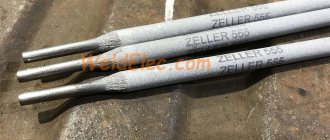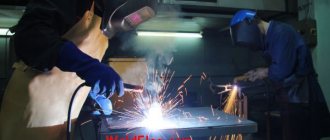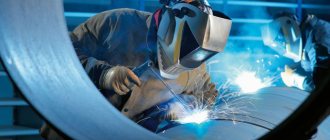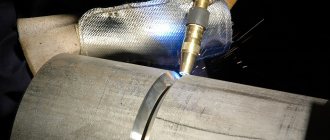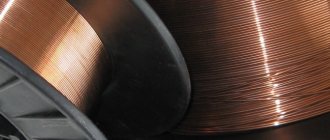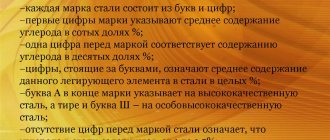Low Carbon Steel Welding Technology
Tool steel contains up to 1% carbon, which determines its hardness and strength. At the same time, the wear resistance of the metal is quite low, so only tools are made from it. And the low purchase price ensures the profitability of production.
The technology for welding steel of this type involves the use of an inverter and a specially designed electrode. UONI-13/NZH/20X13 rods and a welding inverter are suitable for processing.
We recommend articles on metalworking
- Steel grades: classification and interpretation
- Aluminum grades and areas of their application
- Defects in metal products: causes and search methods
Recommendations on how to weld metal correctly
To weld metal correctly, it is not enough just to learn how to make seams. The welder must also be a materials scientist - know a lot about the properties of the materials being welded, their interaction with each other and with high temperatures.
The technology includes many operations before and after the actual seam is completed.
Before starting the main operation, the parts to be welded must be thoroughly cleaned of mechanical impurities, old paint, rust and must be degreased. It is also necessary to correctly position them relative to each other and fix them in this position.
When connecting thin-walled structures or simply long seams, the parts are clamped to each other at several equally spaced points to avoid thermal deformation.
The future welder must know and anticipate in advance:
- potential problems;
- types of defects
and think about how to avoid them.
Start with the three simplest types of connections
- Butt. The edges of the parts to be joined are in the same plane with a small gap between them, and this gap is filled with suture material.
- Overlapping. The parts are arranged with some edge overlap.
- Tavrovy. One plate is welded end-to-end in the middle of the other, usually at a right angle.
Three main types of connection
In general, a welder's job is half welding and half planning and preparation. Learning to cook properly means learning to plan and prepare.
Welding technology for different types of structural steel
Structural steel is more in demand; it is used for the production of both small metal parts and large-scale machines. This category includes steel grades such as 40x, 30xgsa, 35xgsa, etc.
Structural steel contains various impurities, including sulfur and phosphorus. A larger number of these components reduces the reliability of the material.
Structural steel types are divided into several groups:
- ordinary;
- quality;
- high quality;
- especially high quality.
The last group contains a minimum amount of impurities, so the steel is the most durable and of the highest quality. Conventional structural steel, on the contrary, contains a high percentage of impurities, so it is not durable. In these groups there is a division into subgroups depending on the presence of additional chemical elements in the composition.
Specifics of welding copper alloys
Both copper and its alloys have a high level of thermal conductivity, which creates additional problems in the process of obtaining a strong seam at the welding site.
The most common options used in this case include:
- Carrying out mechanized submerged arc welding;
- Gas welding;
- Electron beam welding.
Welding technology of different types of alloy steel
The most popular are various types of alloy steel. The demand for them is due to their composition, which includes various alloying components that give the metal the desired characteristics and properties.
Additives give the metal increased strength, durability, and improve its characteristics. The physicochemical properties of the material are changed by adding alloying components to the composition.
The advantages of different types of alloy steel also include:
- high heat resistance;
- resistance to corrosion (of course, they cannot be compared with stainless steel, but they have increased resistance).
The technology for welding steel of this type involves the use of an arc processing method and electrodes with fluorine and calcium. The best option is to use gas welding; the quality of joining parts in this case is higher.
VT-metall offers services:
The difference in the technology of welding steel with gas and a semi-automatic or inverter lies in the generation of heat due to the flame of a gas burner, rather than an electric arc. A flame occurs when a flammable gas mixes with oxygen. To use gas welding technology for carbon steels, experience and dexterity are required.
Features of welding products made of carbon steel alloys
As is known, carbon alloys are those steel alloys whose carbon content can vary between 0.1–2.07%. Depending on how much carbon such alloys contain in their composition, they are divided into low-carbon (up to 0.25%), medium-carbon (0.25-0.6%), and high-carbon (0.6-2. 07%). Welding low-carbon steels, as well as medium-carbon and high-carbon steels, has certain features. However, there are general rules for carrying out such a process, which make it possible to obtain high-quality and reliable connections for products made of carbon steels.
Technological features of welding carbon steels
To ensure good weldability of the root of the seam when making butt welded joints of parts made of carbon steel, this process is performed while holding the joined products in weight. They try to adhere to this recommendation when performing semi-automatic welding with flux-cored and conventional wire, as well as when performing gas and manual arc welding using coated carbons. When using automatic equipment to weld carbon steels, they try to create conditions to ensure weldability of the root of the weld and eliminate the phenomenon of metal burn-through.
Tack welding is performed with full penetration of the joint and subsequent remelting when applying the main seam
Before starting welding of products made of carbon steels, they must be precisely positioned relative to each other and securely fixed, for which it is best to use special assembly devices. In the absence of such a device, fixation can be ensured using potholders. It is advisable to apply tack welds, the total length of which can reach up to a third of the length of the weld itself, on the side of the parts joining that is opposite to the seam. If a multi-pass weld is to be made, then tack welds are applied on the side of the joint that is opposite to its first layer.
After tacks are completed, they are carefully cleaned, inspected and defects corrected if any are found. When welding carbon steels, it is necessary to achieve complete remelting of the tacks, which otherwise may become a source of cracks at the welding site.
Table of welding modes (using the example of low-carbon and low-alloy steels)
The technology of multilayer or double-sided welding of carbon steels is chosen if the joint being formed must meet increased requirements for its strength and reliability, or parts of significant thickness need to be connected. If, upon inspection of the formed weld, defects are discovered (cracks, pores, undercuts, poorly welded areas, etc.), then the following actions must be taken to eliminate them:
- remove the deposited metal in the area where the defect is detected;
- clean the defect area;
- weld the seam in the cleaned area.
This differential was welded using TIG welding, which ensured high-quality penetration and no spatter
The peculiarity of performing electroslag and automatic welding of parts made of carbon steels is that the products being joined are fixed with a gap, which should have some expansion towards the end. To carry out such fixation, assembly devices or special brackets are used. In order to ensure high quality of the initial and final areas of the weld when using the above technologies, the welding process begins not on the parts themselves, but on special strips fixed with them.
Welding technology for various types of low-alloy steel
The composition of different types of low-alloy steel (most often they are low-carbon steel) contains a small percentage of alloying components (mostly within 2-3%). These metals contain iron, a small percentage of carbon and various impurities.
Low-alloy steel, resistant to high temperatures (up to +200 °C), is used for the production of surgical, jewelry, engraving instruments, razors and blades. Adding a small amount of chromium to the composition allows you to obtain a metal that is characterized by high strength and durability.
Low-alloy steel is included in the class of ferrous metals and is used for the production of dimensional welded metal structures. Although the content of alloying components in its composition is small, the material has high strength. Such characteristics are achieved due to the presence of chromium, nickel and molybdenum in the composition, which improve the properties of low-alloy steel. Thanks to chromium and nickel, the metal's resistance to corrosion increases.
Compliance with the technology of welding steel of this type allows you to achieve good results. However, when working with low-alloy metals, it is necessary to take into account numerous material characteristics. The experience of the welder plays a big role.
Most often, craftsmen encounter overheating of the welded area. This problem arises when working with various grades of low-alloy steels. Due to the rapid cooling of the weld and the workpiece as a whole, mertensite is formed at the joint. This is the name given to the hard carbon structure that appears on the weld due to sudden cooling.
The technology for welding steel with low carbon content involves the use of electrodes with calcium and fluorine. The most suitable rods are those that have a base coating, such as E42A or E50A. The best electrodes are considered to be UONI 13/45, MR-3, ANO-8, SM-11. However, others with similar characteristics will also be suitable.
Low carbon steel welding technology allows the use of semi-automatic or automatic submerged arc welding with semi-automatic and filler wire. Flux can be replaced with carbon dioxide or a mixture of carbon dioxide and argon. This allows you to improve the quality of the seam compared to working with electrodes.
Low carbon
Low-carbon steel, which contains, in addition to carbon, alloying additives, is welded, as a rule, using any of the welding technologies.
The work does not require a highly qualified welder. Such materials are among the easily weldable steels. Therefore, conventional arc welding can be successfully used here.
Features of welding low-carbon steels are a reduced carbon content in the weld metal and an increased amount of alloying additives, so some strengthening of the weld metal in relation to the metal of the parts is possible.
Another problem that should be taken into account is the increased fragility of the seam when performing multi-layer welding.
To make connections on low-carbon steels, electrodes with rutile and calcium-fluoroisrutile coatings are used. Professional welders use electrodes coated with a little iron powder. Of the electrodes produced by industry, the following brands are suitable for welding: UONI-13/85, TsL-14, TsL-18-63.
Low carbon steels are easy to weld using acetylene. In this case, you can even do without the use of flux, and gas is consumed in a small volume.
To obtain a high-quality joint with a strength no less than that of the base metal, silicon-manganese welding wire is used. Upon completion of work with the seam, the flame is not extinguished or removed from the joint of the parts, but is smoothly deflected, allowing the seam to cool.
If you remove the flame immediately, then without flux the weld material, being heated, will oxidize. To give the seam better strength properties, the weld metal is usually forged and heat treated.
Welding technology for steel of various structural classes
Pearlitic and austenitic steels are more difficult to weld, since martensitic deposits or carbide ridges form on the weld, and their volume reduces the degree of alloying of the material, bringing it closer to the characteristics of pearlitic steel. The interlayer is formed due to poor mixing of the liquid metal in the near-wall layers. If the reserve of austeniticity of the metal in the weld area is small, then the interlayer can reach a critical level, leading to the destruction of the joint.
Accordingly, when choosing a steel welding technology, it is necessary to give preference to the one that allows you to achieve a minimum thickness of the crystallization layer. For this:
- use highly concentrated heat sources, for example, electron beam, laser, plasma;
- cut or overlay the edges, reducing the content of steels involved in the process;
- select processing modes in which the melting thickness is minimal;
- arc welding is used in a protective gas environment, which can provide intensive mixing of the metal of the weld pool.
For welding combined steel, the most suitable is processing in a protective gas environment, since when using this technology the temperature of the molten metal increases, the surface tension decreases, and therefore the intensity of its mixing increases. This is due to an increase in the near-electrode voltage drop of the welding arc and the kinetic energy of transfer of electrode metal droplets and plasma flow in the welding arc.
The effect is enhanced by the addition of oxygen, nitrogen, and carbon dioxide to argon. When oxygen is added, the temperature in the weld pool increases and exothermic redox reactions occur. Due to this, the degree of structural and mechanical heterogeneity in the area of connection between the pearlitic metal and the austenitic weld is reduced.
Manual arc technology for welding steel allows one to achieve better results by reducing the melting temperature of the electrodes and, as a consequence, the temperature of the weld pool. To reduce the melting point of the electrodes, rods containing nickel and manganese are used. When using these electrodes during submerged arc welding, crystallization and diffusion layers are also reduced.
Welding high carbon steels
High-carbon steels are difficult to weld and limitedly weldable materials due to their special tendency to hardening, the formation of cracks and other thermal defects. Due to the high complexity of the work, manual methods of electric arc welding are practically not used.
Gas welding
The main method of joining high-carbon steel workpieces is gas welding with preheating to 200-300℃. In some cases, accompanying heating is also used. The work is carried out with a reducing flame or a flame with a slight excess of acetylene, intensity - no more than 90 cubic meters. dm per hour. The “left” method is used, which allows to reduce the time of thermal exposure to the metal .
Wire Sv-15 or Sv-15G is used as an additive, sometimes wires alloyed with chromium, nickel, and manganese. Unlike medium-carbon steels, high-carbon steels are not recommended for forging. If necessary, they are tempered or annealed with complete heating of the workpieces to 350-400℃.
Other welding methods
An alternative method for joining high-carbon steels is beam welding, which is divided into electric beam (directed flow of charged particles) and laser (directed flow of photons). The disadvantages of these technologies include the high complexity and high cost of the equipment, while the advantages include high speed and accuracy of work, short time and small area of temperature influence on the joint.
Resistance, plasma, and electroslag welding technologies are used to a limited extent, which require significant resource consumption, however, they do not solve all the problems associated with imparting the necessary mechanical properties to the seam. One of the promising areas is the connection of high-carbon steel blanks with each other and with other materials by friction welding.
Technologies for welding dissimilar types of steel of the same structural class
Welding of different types of pearlitic steel, the difference in which lies in the degree of alloying, is performed using electrodes used for metals with a lower degree of alloying, in the absence of additional requirements for joint strength, heat resistance, and corrosion resistance, which are characteristic of more alloyed steels. At the same time, the technology involves the choice of welding modes and temperatures used when working with more alloyed metals.
If heating is not possible, then surfacing of the edges is performed using a more alloyed material, heated by electrodes of the E42A type. In this case, the deposited layer must have a thickness that will not allow the more alloyed metal to heat up to Ac1 temperatures, i.e., prevent the creation of conditions for hardening.
When working with various combinations of high-chromium martensitic (12% Cr), ferritic (28% Cr) and ferritic-austenitic metals of the X21N5 type, it is necessary to choose a steel welding technology that will not form cold cracks and brittle areas in the weld. The heating mode is selected for the hardening metal itself, preventing complete cooling of the workpieces. This is possible when using welding materials of the ferritic-austenitic class, welding with minimal heat input, since metals with a high chromium content are susceptible to grain growth, which causes the formation of brittleness of the weld area.
After the heat treatment is completed, the workpiece must be cooled quickly to avoid the brittleness that occurs at +475 °C. Austenitic electrodes can also be used for operation. But in this case, during heat treatment, it is impossible to completely eliminate welding stresses caused by the difference in the linear expansion coefficients of the weld and the base metal.
Stainless steel
Most often, stainless steels used in industry obtain their anti-corrosion properties through the introduction of alloying additives - chromium and nickel.
When welding chrome-plated parts, it must be taken into account that at high temperatures (more than 500 °C), oxidation of the joint of parts is possible.
To avoid this, argon arc welding, or TIG welding (TIG), is used. This technology involves the implementation of welding operations without air access directly to the welding zone. Accordingly, the absence of oxygen, the presence of which is mandatory in the air, eliminates the prerequisites for oxidation of the material.
Limiting the access of air is carried out by introducing argon, an inert gas into the welding zone, which, being heavier than air, displaces it. Sometimes this method is called steel welding with argon. In fact, steel is either simply welded together with an arc, or using filler material.
Tig welding requires special equipment. The work is carried out with non-consumable tungsten electrodes, the requirements for which are determined by GOST 10052-75.
The second problem is this. Stainless steels have a high coefficient of thermal expansion, and when welding sheet steel, when the joint is long in comparison with the linear dimensions of the part, the weld may bend during the cooling process.
The problem is solved by setting gaps between the sheets and using tacks to fix the parts in the desired position.
Welding technology for two-layer (clad) steels
Due to the double-layer steel, the use of high-alloy materials is reduced, while the performance of the structures is not reduced. Equipment used in corrosive environments is made from such metals.
The facing layer up to 12 mm thick, resistant to corrosion and in contact with aggressive environments, is made of the following metals:
- high-alloy chromium-nickel austenitic (12Х18Н10Т, 08Х18Н10Т, 12Х18Н12Т, 08Х18Н12Б, etc.);
- chromium ferritic;
- martensitic-ferritic (08X13, 12X13, etc.).
The main layer, whose thickness reaches 150 mm, is more resistant to force loads. For its manufacture, low-alloy carbon metals are used (St3, 20K, 15ХМ, etc.). Welded joints must have:
- Uniformity of the facing layer with high corrosion resistance of the weld.
- Absence of complex alloys with low mechanical characteristics at the junction of the facing and base layers. To do this, it is necessary to use suitable materials and steel welding technology, cut edges and carry out work consistently.
GOST 16098-80 is devoted to a description of the main types and structural elements of the edge preparation form in accordance with the technology and welding methods. Welding of layers is carried out separately using different welding materials. The facing layer is processed last to prevent it from reheating. The base coating is processed first. Suitable welding wires, fluxes, electrodes, etc. are used for the job.
Equipment selection
The type and operational features of welding equipment for working with carbon steels vary widely and depend on factors such as:
- selected welding method;
- workpiece characteristics;
- required seam quality;
- design welding mode;
- features of the external environment;
- required performance;
- financial and economic criteria.
Most often, carbon steels are joined using one of the electric arc welding methods. If manual welding is expected and the amount of work is relatively small, you can use a conventional welding inverter, the main advantages of which are its compactness and low cost. A good choice would be the Fubag IR 200, Wester MMA-VRD 200, Elitech AIS 200, Resanta SAI-220 and others.
Approximate cost of Resanta SAI-220 devices on Yandex.market
Otherwise, it is better to give preference to industrial transformers with higher performance, for example, Kavik TDM-252U2 (250 A, 12 kW) or Brima TDM1-315-1 (315 A, 24 kW). In areas where connection to the electrical network is impossible or difficult, welding generators equipped with internal combustion engines are used.
For semi-automatic welding in shielding gases or under a layer of flux, specialized welding machines of a combined design are used, which provide the generation of welding current, as well as the supply of shielding gas and a consumable electrode to the welding zone (in addition, filler wire can be supplied). In the niche of budget models, the leader is Aurora Overman 180, in the top segment – Blueweld Starmig 210 Dual Synergic.
Approximate cost of Aurora overman devices on Yandex.market
For gas welding, you will need oxygen and acetylene cylinders with pressure gauges, flexible hoses and a torch that allows you to adjust the proportional ratio of gases. Equipment for alternative types of welding is specific; it belongs to industrial devices and is extremely rarely used in everyday life.
Provider
Are you interested in welding and cutting tool steels? Welding and cutting of tool steels from the supplier "Auremo" comply with GOST and international quality standards. The supplier "Auremo" offers tool alloys, the price is optimal. We offer to buy alloy tool steels from specialized warehouses of the supplier “Auremo” with delivery to any city. Alloy tool steel is always available, the price is optimal from the supplier. We are waiting for your orders.
Buy, favorable price
The supplier "Auremo" offers to buy alloy tool steel, the price is determined by the technological features of production without including additional costs. The company's website displays information about the latest product arrivals. The order price depends on the volume and additional delivery conditions. We invite you to buy alloy tool steel in bulk or in installments. We have the best price-quality ratio for the entire range of products. It is a profitable supplier in this segment.
Composition and properties of high-strength steels
Steels with a tensile strength greater than 1500 MPa are called high-strength. This limit is achieved by selecting the chemical composition and the most suitable heat treatment. This level of strength can be formed in medium-carbon alloy steels (40ХН2МА, 30ХГСН2А) by using hardening with low tempering (at 200...250оС). Alloying such steels with W, Mo, V complicates softening processes, which reduces the threshold of cold brittleness and increases resistance to brittle fracture. How to weld metal if you have high-strength steel in front of you? Welding of high-strength steels is characterized by the use of some additional technological techniques (welding in cascades, slides, sections, preheating, the use of a soft layer, and others).
Hardened steels (structure)
Isothermal hardening of medium-carbon alloy steels gives them slightly lower strength, but greater toughness and ductility. Therefore, they are more reliable in operation than low-tempered and hardened ones. Low-tempered and hardened medium-carbon steels with a high level of strength have an increased susceptibility to stress concentrators and a tendency to brittle fracture. Because of this, they are recommended to be used for work involving smooth loading.
High-strength steels include so-called spring steels. They contain 0.5...0.75% C and are additionally alloyed with other elements. Heat treatment of alloy spring steels (quenching 850...880°C, tempering 380...550°C) ensures high strength and fluidity. Isothermal hardening can be used. Welding of spring steel is carried out with mandatory preliminary heat treatment, with heating during welding and further heat treatment.
Maraging steels (04Х11Н9М2Д2ТУ, 03Н18К9М5Т) also belong to high-strength steels. They are superior to medium-carbon alloy steels in structural strength and manufacturability. Such steels are characterized by high resistance to brittle fracture, a low threshold of cold brittleness and low sensitivity to cuts with a strength of about 2000 MPa. Maraging steels are carbon-free alloys of iron and nickel and are additionally alloyed with molybdenum, cobalt, aluminum, chromium, titanium and other elements. These steels have high structural strength in the temperature range from cryogenic to 500°C and are used in the manufacture of artillery and small arms barrels, rocket engine housings, gears, spindles, and so on.
What to consider when welding titanium and titanium alloys
Initially, it should be noted that titanium is a metal characterized by a high melting point, which often reaches about 1600°C.
In addition, there is a well-founded opinion among professionals that titanium melting is one of the most complex processes.
This situation is explained by the fact that in its pure form it reacts with oxygen, as well as nitrogen.
- In order to carry out high-quality welding of metal products, it is necessary to ensure a rapid welding process without a gradual increase in temperature.
- It is also important to take into account that a feature of titanium is its active reaction with oxygen and nitrogen.
- This, in turn, indicates the need to isolate the welding zone from the influence of atmospheric air.
In order to join titanium components, it is necessary to ensure rapid welding without ensuring a gradual increase in temperature.
That is why, one of the most common options for joining titanium, as well as its alloys, is the use of argon welding.
Thus, it is necessary to pay attention to the fact that, based on the characteristics of the metal used, it is extremely important to take into account the characteristics of the material used, which will help ensure the achievement of a quick and effective result.


